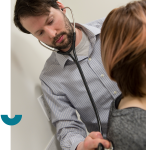Share
Medical Matters: Salutations from Accreditation
Back to MessengerRead time: 4 minutes
By: Dr. Jeremy Beach, Assistant Registrar, Accreditation
As some of you may know, I joined CPSA some seven years ago to work in the Physician Health Monitoring Program—now known as the Health & Practice Conditions Monitoring program (HPCM). I had been interested in physician health over a number of years, starting in 1993 with a report I authored for the British Medical Association. With some reorganizations at CPSA occurring last year, I took on my current role as Assistant Registrar, Accreditation. While it appears to be a stretch from physician health monitoring, it’s not as different as it might seem.
In both roles, I have been gratified to see the benefit of supporting and guiding physicians as individuals and within their respective health facilities. Both HPCM and CPSA’s accreditation program seek to provide regulated members with helpful tools, resources and standards with the ultimate aim of improving patient care, an ambition I know is shared by all physicians in Alberta. In this month’s Medical Matters, I’d like to discuss some of my recent observations while settling into my new role with the Accreditation team and reflect a little on how facility accreditation—and the teams within these facilities—can contribute to high-quality care.
Accreditation at a glance
The Accreditation program at CPSA has been in existence since 1968, initially starting as a program to accredit laboratories, but expanding in short order to include diagnostic imaging facilities and others. The intention of the program was (and remains) to ensure that Albertans, when going for blood work, x-rays or other diagnostic and out-of-hospital medical services, can be assured that they will receive safe, high-quality care. CPSA’s facility accreditation standards play a vital role in this by providing a benchmark and, as you can imagine, go through a careful development process. CPSA’s Accreditation team works in collaboration with committees, field experts, other regulators, standard-setting bodies and industry associations when drafting these standards. CPSA Council is ultimately responsible for approving accreditation standards, and the Accreditation program then uses those standards in the field when assessing facilities. Some of these facilities include cardiac stress testing, diagnostic imaging, diagnostic laboratory medicine, hyperbaric oxygen therapy, neurodiagnostic, non-hospital surgical procedures, psychedelic-assisted psychotherapy, pulmonary function diagnostics and sleep medicine diagnostics.
Facilities are assessed when they first open or anytime they renovate, move or add a new service. They’re also re-evaluated every four years or sooner if a concern is raised. Accreditation standards are reviewed every year, undergoing a complete and comprehensive review every four years to ensure they are updated to reflect the current expectations for the type of facility covered. As standards and facilities are reviewed cyclically, the accreditation team also makes changes according to evolving legislation and looks for new ways to better support quality of care across the province. Accreditation also actively works towards creating cultures of quality improvement and assurance to ensure progress is monitored and maintained over time. If you have comments or questions about the accreditation standards, or suggestions for where they may be improved, please let us know.
Psychedelic-Assisted Psychotherapy
One recent development within the Accreditation department was the addition of psychedelic-assisted psychotherapy (PAPT) to the types of facilities requiring accreditation. Recent evidence has indicated that PAPT can play an effective role in a comprehensive care plan for people with certain psychiatric disorders, such as PTSD and treatment-resistant depression. Not surprisingly, this created some pressure for treatment to be available in Alberta and one mechanism to try to do this was through an amendment to the Mental Health Services Protection Regulation that allowed for PAPT to be provided in the community within a CPSA-accredited medical facility.
In response to these requirements, CPSA developed and launched a new set of PAPT accreditation standards. These were based in part on other resources, such as the International Organization for Standardization (ISO) and the Canadian Standards Association (CSA) standards, but also required extensive local input. Before facilities may provide this therapy, they must be assessed using these standards and accredited by CPSA. Facilities will be provided with access to the PAPT standards once they have registered for assessment.
Medical Director Training
In September 2023, our Accreditation team launched a new Medical Director Training program designed specifically for medical directors of community-based accredited facilities. We recognized that this role is central to effective interaction between a facility and CPSA, but that there was little formal training for this aspect of the position. This training, available on CPSA’s e-learning platform, MyCPSA, provides medical directors with support and guidance in managing the important responsibilities of their role in continuing to provide high-quality services for their patients.
The program consists of three modules and was designed to be flexible and self-paced, taking approximately 80 minutes to complete. Medical directors who were required to complete the program were contacted directly and given a due date for completion. We would like to thank the over two hundred medical directors who have successfully completed their training. Your commitment to your role and providing high-quality care to your patients is greatly appreciated.
Release of Diagnostic Imaging Standards (v4)
Early this year, CPSA released version 4 (v4) of the Diagnostic Imaging accreditation standards. Some notable revisions included revised teleradiology standards and criteria, the addition of a 25 km radius distance restriction for the provision of tele-ultrasound and requirements for imaging facility medical directors. By updating and amending these standards to better reflect the current climate and meet newfound requirements within diagnostic imaging, we are confident that facilities will be better prepared to meet the varying medical needs of Albertans. The (v4) standards are effective as of Jan. 31, 2024, for new facilities and existing facilities requesting additional modality approvals. All other facilities are expected to achieve (v4) compliance as of Oct. 1, 2024.
The revisions to this standard are consistent with other jurisdictions and better align with our accreditation standards and references. They have been thoughtfully and carefully discussed by various levels of CPSA committees since 2018, with feedback and draft revisions stemming from multiple stakeholder and focus group consultations. We would like to express our gratitude to all stakeholders who provided invaluable feedback through numerous broad provincial surveys. We are very thankful for the tireless efforts of all CPSA committees involved in guiding the revisions.
The work continues towards enhanced patient experiences
With a passion for quality assurance and improvement, the Accreditation team actively searches for ways to better support diagnostic and non-hospital surgical facilities across the province. Preparations and planning are always underway to enhance and contribute to the Alberta patient experience and we look forward to a busy year ahead as more projects come to fruition.
Do you have questions or feedback for our accreditation team? I’d love to hear from you in the comments below or via email.
 |
Dr. Jeremy Beach obtained his medical degree in the U.K. in 1983 and subsequently specialized in occupational medicine. Prior to his arrival in Canada, he worked in the U.K. and Australia, with a short spell in Malaysia. Dr. Beach moved to Canada in 2002 to work as the residency program director in occupational medicine at the University of Alberta. He joined the CPSA as Assistant Registrar in the Physician Health Monitoring Program in 2016. His interest in physician health stretches back to when he prepared a report for the British Medical Association that was published in 1993 on the Morbidity and Mortality of the Medical Profession. |
Related News
All News & EventsMay 9, 2024
A dynamic duo: PPIP and CPSA’s Standards of Practice
May 9, 2024
Join our team: Assistant Registrar, Registration and Registration Assessments
May 9, 2024
Reminder: Diagnostic Imaging Version 4 Accreditation Standards
May 9, 2024
























Comments for this post are now closed. If you would like to share your feedback on this topic, please email support@cpsa.ca.